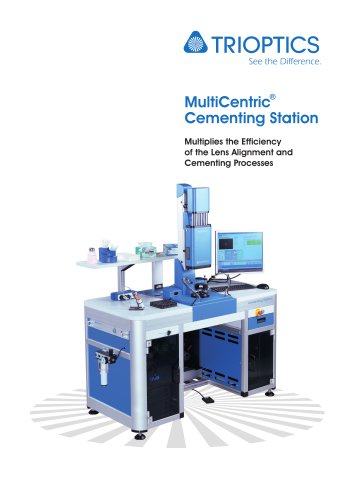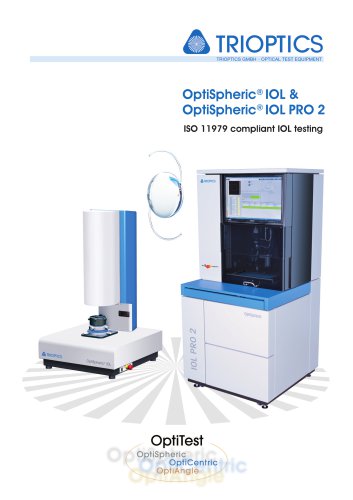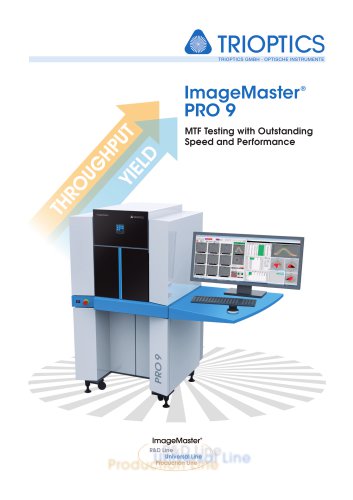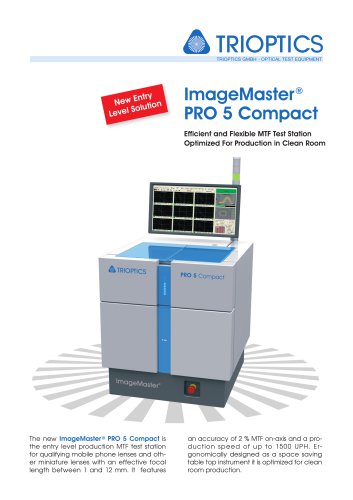 Website:
TRIOPTICS
Website:
TRIOPTICS
Catalog excerpts
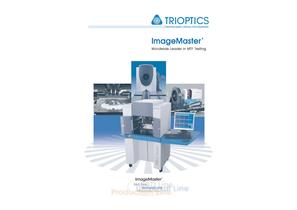
ImageMaster® Worldwide Leader in MTF Testing
Open the catalog to page 1
Overview 3 quality of a lens, ImageMaster® Series is able to measure a wide range of other optical parameters: • Effective Focal Length (EFL) • Flange Focal Length (FFL) • Back Focal Length (BFL) • Distortion • Field Curvature • Chromatic aberrations • Astigmatism • Relative Transmission • Vignetting • Field of View • Chief Ray Angle • Depth of field, etc. Designed for complete characterization of optical systems The ImageMaster® Series has been designed to measure the MTF (Modulation Transfer Function) describing the optical performance of lenses and optical systems. ImageMaster® is able...
Open the catalog to page 2
Overview 5 Widespread Applications TRIOPTICS offers the widest and most advanced product series for MTF measurement world wide. No matter how small or large, any lens from tiny micro lenses to large telescope objectives can be accurately measured. The multitude of models offered by the ImageMaster ® series allows for MTF measurements over the whole spectral range from UV (<200 nm) over visual spectral range up to far infrared (14 ìm). ImageMaster® series covers a large variety of applications: • Digital camera lenses • Mobile phone lenses • Copier and enlarger lenses • Camera modules for...
Open the catalog to page 3
The ImageMaster® R&D Line provides an outstanding level of accuracy and flexibility. The equipment is modular and upgradeable to allow for custom configuration as test requirements change. The instrument can be configured for testing optical systems with: • object at infinity • object and image at finite conjugates • afocal systems The equipment range includes the following product versions: ImageMaster® Compact is a cost-effective, horizontal table-top instrument intended to be used in prototype and small series production qualification. Both easyto- use and inexpensive, ImageMaster®...
Open the catalog to page 4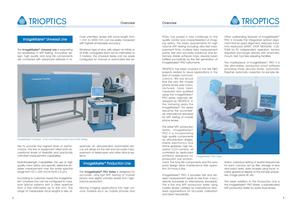
The ImageMaster® Universal Line is supporting our leadership in MTF-Testing. Innovative design, high quality and long life components are combined with advanced software in order to provide the highest level of performance. This line of equipment offers both exceptional levels of flexibility and practically unlimited measurement capabilities. Multi-Wavelength Capabilities: the use of high quality mirror optics and specific detectors enables measurement over the entire spectral range from UV (<200 nm) to far IR (14 ìm). According to customer needs the ImageMaster ® Universal Line can be...
Open the catalog to page 5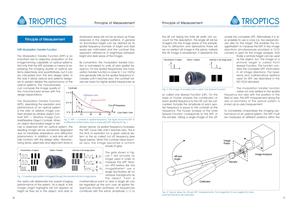
this slit not taking the finite slit width into account for this description. This single slit will be imaged into the image plane of the sample. Due to diffraction and aberrations there will be no perfect slit image in this plane, instead the slit image is broadened. It represents the so called Line Spread Function (LSF). On the basis of Fourier analysis the contribution of each spatial frequency to the LSF can be calculated. Actually the amplitude of each spatial frequency is equal to the contrast at this frequency. The Fourier analysis of the Lines Spread Function corresponds to the MTF...
Open the catalog to page 6
way, the EFL is calculated as an absolute quantity, not depending on calibration parameters. Depth of focus The depth of focus, is the extent of the region in front of and behind the image plane in which the image will appear to be sharp. The depth of focus can be determined using a "through focus scan" of the MTF and setting appropriate tolerances for the drop in MTF. The depth of focus between the set tolerances will be measured and displayed. A more complex measurement can be done simulating the range of object distances covered by the lens and measuring the MTF at the corresponding...
Open the catalog to page 7
Advantages 15 Principle of Measurement 14 F-number The F-Number of a lens is defined by the ratio between the EFL and the diameter of the entrance pupil. The ImageMaster® series instruments use the ISO-517 method to accomplish the measurement: First the EFL is measured according to the procedure described before. Then the sample is turned around with the entrance pupil facing towards the detector head. The diameter of the entrance pupil is measured by first focussing on the left, then on the right edge of the pupil. The travelling distance of the image field stage represents the diameter of...
Open the catalog to page 8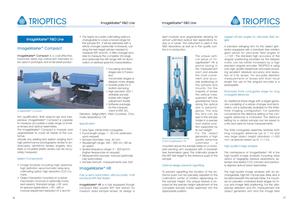
kept modular and upgradeable allowing for almost unlimited optical test applications today or in future. The instrument is used in the R&D laboratory as well as in the quality control or in production. The unique vertical setup of ImageMaster ® HR is space saving in the measurement room and ensures the most convenient and accurate positioning of the sample lens mounts. For the majority of lenses this vertical measurement with the gravitational force along the optical axis is advantageous. This way the lens can be kept in the sample holder in a precise and stable position supported by its...
Open the catalog to page 9
defined measurement procedures and Microsoft Excel export. • Classical and reverse imaging configuration possible Classical Configuration In this test configuration the collimator on the pivoting arm projects the test target towards the entrance pupil of the sample. The sample is imaging the target to its focal plane. This image of the test target is magnified by the microscope relay lens and projected onto a CCD sensor. The instrument can be configured for testing optical systems with: • object at infinity using the collimator on the pivoting arm • object and image at finite conjugates...
Open the catalog to page 10
ImageMaster® R&D Line 21 • Simultaneous measurements of the EFL and the MTF using special target patterns and dedicated software routines • Conventional MTF measurement using a single slit or a crosshair as a target • Optionally automated selection and positioning of the suitable reticle (target) for the current application • Configuration files with optimized process parameters and password protected access for operator and supervisor • Script tools for custom programming and analysis • Data export and data processing with MS Excel The ImageMaster® can be configured to measure the MTF in...
Open the catalog to page 11All TRIOPTICS catalogs and technical brochures
-
SortMaster
2 Pages
-
ImageMaster-MF-200-Smart
2 Pages
-
ImageMaster-PRO-5-Compact
2 Pages
-
ImageMaster-PRO-5-Ultra
2 Pages
-
ImageMaster-PRO9
4 Pages
-
ImageMaster-Universal-3D
4 Pages
-
ImageMaster-HR-2016
4 Pages
-
ATS-200
20 Pages
-
Laser Rod Test Station
2 Pages
-
OptiCentric® UltraPrecision
8 Pages
-
OptiCentric® IR
40 Pages
-
triangle
2 Pages
-
Spherometers
8 Pages
-
OptiSurf®
2 Pages
-
S p e c t r o M a s t e r
20 Pages
-
OptiSpheric
20 Pages
-
Opticentric
16 Pages
-
PrismMaster®
16 Pages
-
OPTOMATIC optical test instrument
12 Pages













